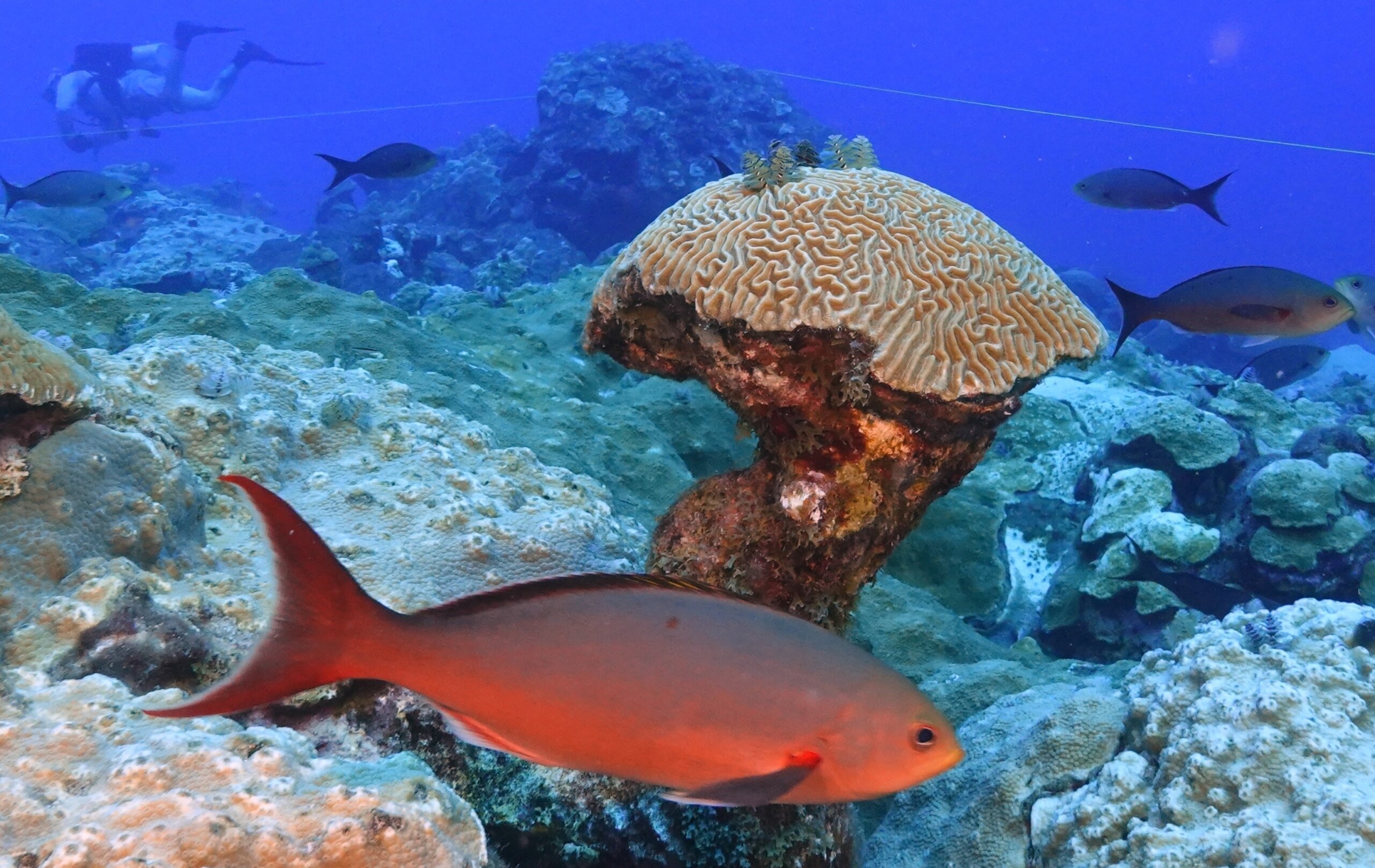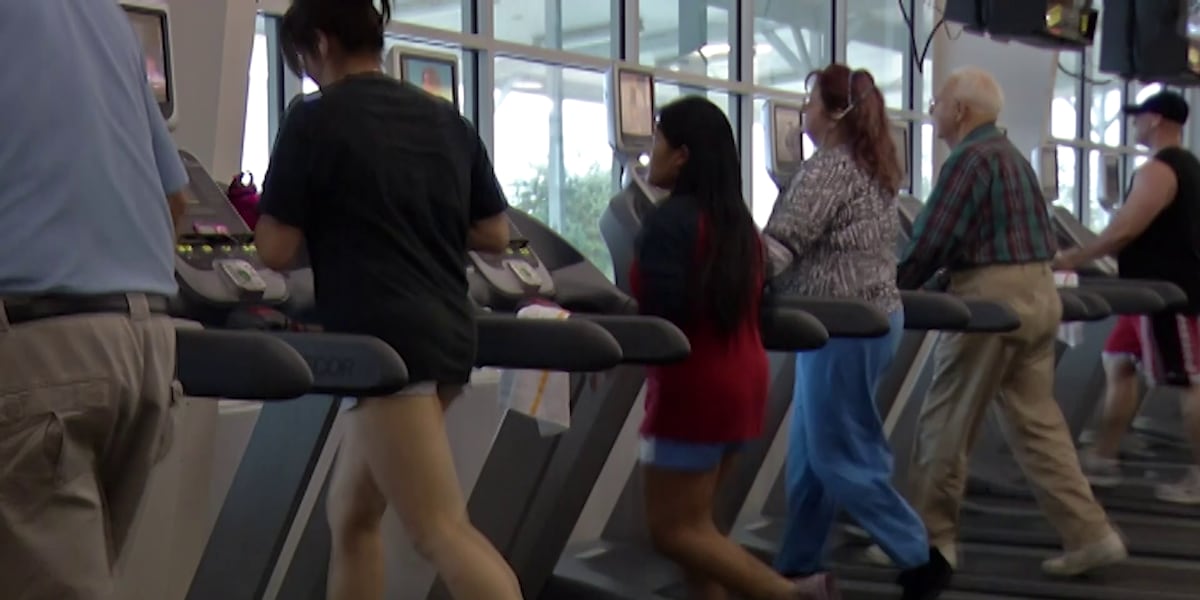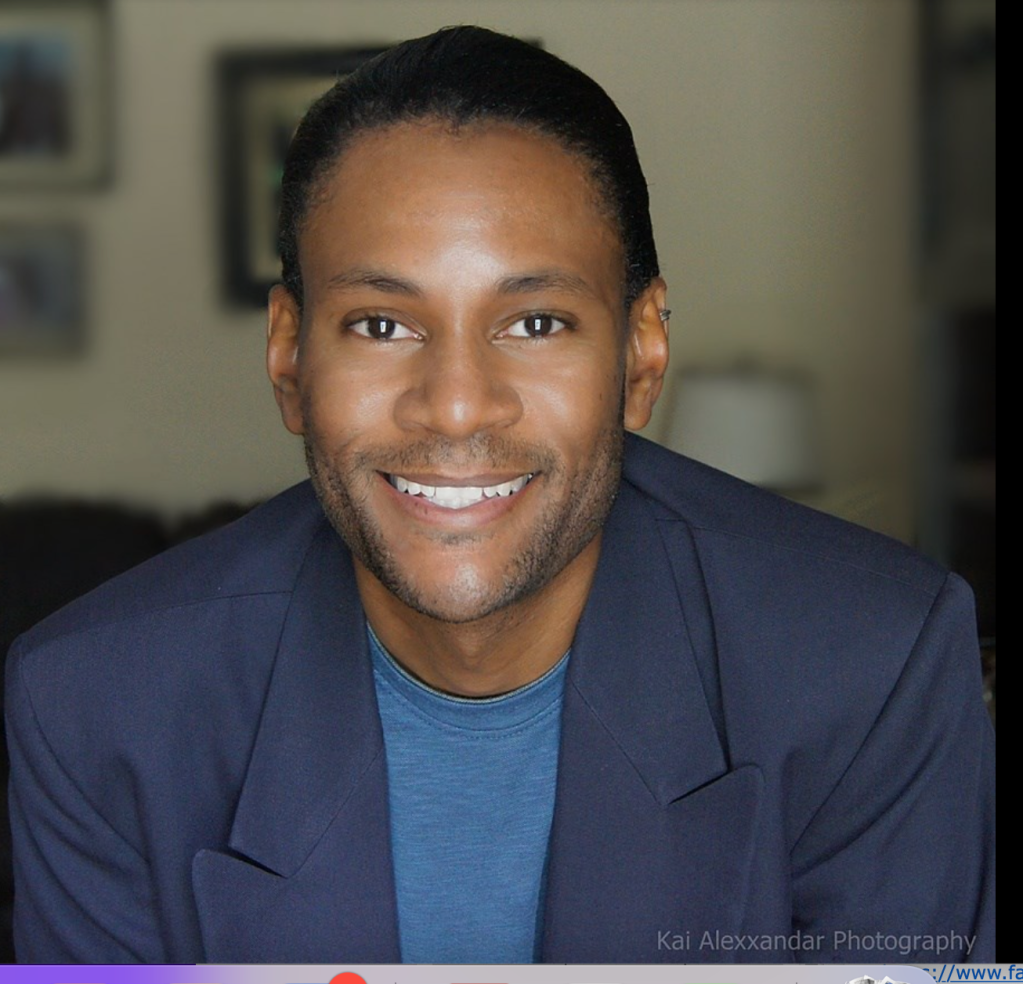Texas
Climate change is hurting coral worldwide. But these reefs off the Texas coast are thriving – WTOP News

OFF THE COAST OF GALVESTON, Texas (AP) — Divers descending into azure waters far off the Texas coast dip below…
OFF THE COAST OF GALVESTON, Texas (AP) — Divers descending into azure waters far off the Texas coast dip below a horizon dotted with oil and gas platforms into an otherworldly landscape of undersea mountains crusted with yellow, orange and pink coral as far as the eye can see.
Some of the world’s healthiest coral reefs can be found in the Gulf of Mexico, about 100 miles (160 kilometers) off the Texas coast. Sheltered in a deep, cool habitat far from shore, the reefs in the Flower Garden Banks National Marine Sanctuary boast a stunning amount of coral coverage. But scientists say that like all reefs, they are fragile, and their location will only offer protection for so long in the face of a warming climate.
“To see that much coral in one place is really magnificent — an experience that most people don’t get on reefs in this day and age,” said Michelle Johnston, the acting superintendent and research coordinator for the federally protected area.
The sanctuary had some moderate bleaching this year but nothing like the devastation that hit other reefs during the summer’s record-breaking heat. Still, Johnston said that’s among her top concerns for the sanctuary’s future. Waters that get too warm cause corals to expel their colorful algae and turn white. They can survive if temperatures fall but they are left more vulnerable to disease and may eventually die.
Florida’s coral reef — the world’s third-largest — experienced an unprecedented and potentially deadly level of bleaching over the summer. Derek Manzello, coordinator of the National Oceanic and Atmospheric Administration’s Coral Reef Watch, said that so far this year, at least 35 countries and territories across five oceans and seas have experienced mass coral bleaching. He said it’s too early to know how much of Florida’s reefs will recover since coral may die as much as a year or two after the bleaching.
Manzello said climate models suggest that all of the world’s coral will be suffering severe bleaching every year beginning around 2040.
“If you have severe bleaching events every year, the prognosis is not good because that basically means the corals aren’t going to have a chance to recover,” he said.
Sanctuary officials say even in the occasional years when Flower Garden Banks has experienced more serious bleaching than this year, it has bounced back quickly thanks to its overall health and depth, and it’s already recovering this year.
A report expected in the coming months will look at the sanctuary’s vulnerability to the projected effects of climate change.
The Flower Garden Banks stands out for its amount of coral cover — an average of over 50 percent across some areas of the sanctuary — compared with around 10 percent cover in the Caribbean and Northwest Atlantic region, Manzello said. Its corals are also about 60 feet (18 meters) below the surface and surrounded by even deeper waters, compared with many reefs where corals are in shallower water just offshore.
In the early 1900s, fishermen told of peering into the Gulf’s waters and seeing a colorful display that reminded them of a blooming garden, but it was such an unusual spot so far from shore that scientists making the initial dives in the 1960s were surprised to actually find thriving coral reefs.
The corals in the Flower Garden Banks were able to flourish so far from shore because of mountain-like formations called salt domes, which lifted the corals high enough to catch the light, Johnston said.
Divers travel from around the world to see the reefs at Flower Garden Banks, where colorful fish, manta rays, sharks and sea turtles waft through and worms that look like Christmas trees pop in and out of corals.
Andy Lewis, a Houston attorney, said he knew from his first trip to the sanctuary about a decade ago that it was “going to have to be part of my life.” Lewis became a divemaster and is now president of Texas Caribbean Charters, which takes about 1,000 people a year out on diving trips there, with about half making a return trip.
“It’s just a real adventure,” said Lewis, who also serves on the sanctuary’s advisory board. “I love getting on the boat.”
That boat leaves from a spot near Galveston, where currents from Mississippi River drop sediment that turns the water near shore a murky brown. By the time the boat motors out to the sanctuary, the water is clear and blue.
“You drop down and you are on top of live coral as far as you can see,” Lewis said.
Lauren Tinnes, a nurse from Colorado, described rounding a bluff on her dive this fall and being surrounded by massive reefs as schools of fish darted through. She found the description from so long ago apt: “It’s like a field of flowers,” she said.
The Flower Garden Banks is one of 15 national marine sanctuaries and two national marine monuments protected by the NOAA’s Office of National Marine Sanctuaries, and the only one in the Gulf of Mexico.
The sanctuary is made up of 17 separate banks that cover 160 square miles (414 square kilometers). When it was designated in 1992, the sanctuary had two banks. Its largest and most recent expansion of 14 banks came in 2021, a process that included input from the advisory committee, which includes representatives from industries that rely on the Gulf, from oil and gas to recreation to fishing.
Johnston said that one way to help the reefs stay healthy is to reduce stresses. That includes making sure mooring buoys offer boats a place to tie up so their anchors don’t damage reefs, and removing invasive species that could cause the number of fish to decline.
Manzello said efforts like those are being done in hopes that greenhouse gas emissions will also be cut globally.
“We need all of these things happening in concert to really shepherd coral reefs through the next 20, 30, 40 years,” Manzello said.
Coral reefs support about a fourth of all marine species at some point in their life cycle. They are also economic drivers. By providing a home for fish that keeps them healthy, they support commercial fishing in addition to bringing in tourism revenue.
“Because coral reefs are declining all over the globe, when we find ones that are healthy, we want to keep them that way,” said Kelly Drinnen, education and outreach specialist for the Flower Garden Banks. “And they kind of serve as the repositories for what could help restore some other reef potentially in the future.”
In fact, samples of healthy corals from the sanctuary are being banked and studied in a lab at Galveston Island’s Moody Gardens, a tourist destination that includes an aquarium. That includes growing out fragments of coral with hopes of someday replanting them.
The Flower Garden Banks weren’t damaged by the massive oil spill that followed the deadly 2010 explosion on the Deepwater Horizon drilling rig, but other reefs in the Gulf were. Data gathered from studying the sanctuary’s deeper habitat is being used to help guide restoration of those reefs.
Researchers are also studying the genetics of the Flower Garden Banks coral, including whether it’s different than species in Florida.
“The more knowledge we have, the better we are equipped to try to protect that reef,” said Brooke Zurita, a senior biologist at Moody Gardens.
___
Stengle reported from Dallas. LaFleur reported from Galveston.
___
Associated Press climate and environmental coverage receives support from several private foundations. See more about AP’s climate initiative here. The AP is solely responsible for all content.
Copyright
© 2023 The Associated Press. All rights reserved. This material may not be published, broadcast, written or redistributed.

Texas
North Texas band to participate in Presidential Inaugural Parade

A North Texas band is among the nearly 40 participants selected to march in the Presidential Inaugural Parade on Monday.
The parade followed the swearing-in ceremony.
The Shivam Dohl Tasha Pathak is a Plano-based group blending a traditional Indian drum and symbol ensemble with modern music.
The band was started a decade ago by Harish Nehate and Nikhil Potbhare.
“Our effort has been to take it out and let everyone enjoy it. It is music, I mean, no one is bereft of music,” said Potbhare.
The band, which now includes dozens of members, has performed at several sporting events like a Mavs game last year.
But Monday night practice in a parking lot in Plano was for a much broader audience.
“We have to practice, practice, practice until we don’t get it wrong,” said Nehate.
On Monday, the group will perform in the Presidential Inaugural Parade after accepting an invitation last month from the Trump Vance Inaugural Committee.
“I see this email and I just start shouting and they’re like, ‘What happened?’ and I’m like, we’re going to DC!” said Nehate.
The President, Vice President, their spouses, and special guests will watch the parade as it passes in front of the Presidential Reviewing Stand, according to the schedule of events.
The 1.8-mile route begins at the Capitol and ends at the White House.
“Getting accepted is such an amazing thing to experience, I mean, think about it,” said Potbhare.
Selected out of numerous applicants, they are one of two bands invited from Texas.
Drummer Pranav Bhosale says this will be the first time an Indian group has ever performed at an inaugural parade.
“So it is an honor for our group to do it for the first time,” said Bhosale.
Texas
See how Texas House members voted in the speaker race

Sign up for The Brief, The Texas Tribune’s daily newsletter that keeps readers up to speed on the most essential Texas news.
On Tuesday, the Texas House voted for a new speaker in a race that will greatly impact the 2025 legislative session.
Rep. Dustin Burrows, R-Lubbock, was able to pick up enough votes from both Democrat and Republican members to secure the win after two rounds of voting.
Burrows defeated Rep. David Cook, R-Mansfield, after the two candidates went to a runoff. In the first round of voting, Rep. Ana-María Rodríguez Ramos, D-Richardson, did not receive as many votes as Burrows and Cook and was eliminated from the race.
Here’s how lawmakers voted in the runoff between Burrows and Cook:
Texas
Area educators discuss top issues as new Texas Legislature begins

AUSTIN, Texas – As the 89th Texas Legislature begins in Austin on Tuesday, lawmakers will again resume debate around familiar topics gaining steam across the state.
The Texas Legislature consists of the House of Representatives, the lower chamber with 150 members, and the Senate, which is the upper chamber with 31 members.
KSAT sat down with two political science professors in San Antonio to discuss some of the top issues likely to permeate throughout the Republican-led session.
Jon Taylor, department chair of political science and geography at the University of Texas at San Antonio, pointed to similarities in the dysfunction between lawmakers in Austin and Washington, D.C.
“It’s almost as though Austin has turned into a mini version of Washington, DC, particularly in terms of the US House versus the Texas House in the sense of they seem to be dysfunctional in trying to find a speaker, massive fights over that (and) factionalism within the Republican party,” Taylor said.
Electing a speaker is likely to be one of the first things on lawmakers’ agendas in the Texas House.
Dade Phelan (R-Beaumont), pushed out by other party members, will soon give up the gavel.
Two candidates have drawn near-constant conversation in legislative circles as ideal candidates: David Cook (R-Mansfield) and Dustin Burrows (R-Lubbock). A third candidate, Ana-María Rodríguez Ramos (D-Richardson) has not garnered as much attention.
While it is more than likely that a Republican will assume Phelan’s role, Trinity University Political Science Professor Juan Sepulveda said the question is much more about what kind of Republican will take charge and what they would want to push forward.
“This is really a battle within the Republican Party,” Sepulveda said. “This is not a question of ideology. This is not about being conservative or moderate or liberal. They are both very conservative leaders. But this is really about power.”
After a speaker is elected, members of the House will offer amendments to and vote on House rules that will define governance for the body’s work.
In a slight decrease from the last legislative session, Texas Comptroller Glenn Hegar projected Monday state lawmakers would have about $195 billion for the 2026-2028 budget, according to reporting by the Texas Tribune.
Throughout the session, lawmakers are constitutionally required to pass a balanced budget without overspending what is available.
Governor Greg Abbott will announce his list of priority items later, determining which legislation can be moved in the session’s first 60 days.
As the session begins and committees begin to hear bills, we can expect familiar topics around school vouchers, immigration and property taxes.
Tayor thinks some of San Antonio’s needs will be at the forefront, too.
“There is a real need to push and to think long-term, planning for things such as water, “Taylor said. ”Additionally, I think an area for at least an issue for San Antonio is to look for state support for in particular for transportation, public transportation, not just building freeways, but to build public transit systems.”
Another piece of legislation that could affect us locally is a bill filed by San Antonio Senator José Menéndez to address dangerous dog incidents.
“This is not a Democratic Party political issue. This is something we’ve been kind of seeing as a community. So. And he’s got and he’s been there long. He’s got good relationships. So it wouldn’t surprise me if he’s able to kind of get something done.
Related coverage on KSAT:
Copyright 2025 by KSAT – All rights reserved.
-

 Health1 week ago
Health1 week agoOzempic ‘microdosing’ is the new weight-loss trend: Should you try it?
-
/cdn.vox-cdn.com/uploads/chorus_asset/file/25822586/STK169_ZUCKERBERG_MAGA_STKS491_CVIRGINIA_A.jpg)
/cdn.vox-cdn.com/uploads/chorus_asset/file/25822586/STK169_ZUCKERBERG_MAGA_STKS491_CVIRGINIA_A.jpg) Technology6 days ago
Technology6 days agoMeta is highlighting a splintering global approach to online speech
-

 Science4 days ago
Science4 days agoMetro will offer free rides in L.A. through Sunday due to fires
-
/cdn.vox-cdn.com/uploads/chorus_asset/file/25821992/videoframe_720397.png)
/cdn.vox-cdn.com/uploads/chorus_asset/file/25821992/videoframe_720397.png) Technology1 week ago
Technology1 week agoLas Vegas police release ChatGPT logs from the suspect in the Cybertruck explosion
-

 Movie Reviews1 week ago
Movie Reviews1 week ago‘How to Make Millions Before Grandma Dies’ Review: Thai Oscar Entry Is a Disarmingly Sentimental Tear-Jerker
-

 Health1 week ago
Health1 week agoMichael J. Fox honored with Presidential Medal of Freedom for Parkinson’s research efforts
-

 Movie Reviews1 week ago
Movie Reviews1 week agoMovie Review: Millennials try to buy-in or opt-out of the “American Meltdown”
-

 News1 week ago
News1 week agoPhotos: Pacific Palisades Wildfire Engulfs Homes in an L.A. Neighborhood















